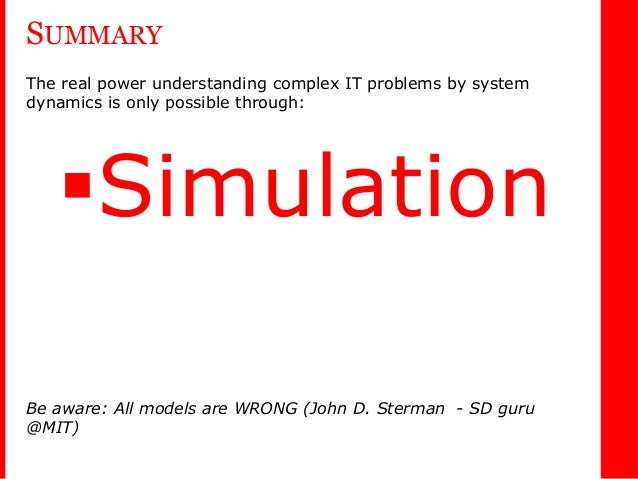System Dynamics Sterman
P.90 The time horizon of the process we are trying to model using system dynamics. Should extend far enough into the future to capture the delayed and indirect effects of potential policies. Most people dramatically underestimate the length of time delays and select time horizons that are far too short. A principal deficiency in our mental models is our tendency to think of cause and effect as local and immediate. But in dynamically complex systems, cause and effect are distant in time and space.
Most of the unintended effects of decisions leading to policy resistance involve feedbacks with long delays, far removed from the point of decision or the problem symptom. P.94-95 Once the problem has been identified and characterized over an appropriate time horizon, modelers must begin to develop a theory, called a dynamic hypothesis, to account for the problematic behavior.
Many times the purpose of the model is to solve a critically important problem that has persisted for years and generated great conflict and not a little animosity among members of the client team. All will tenaciously advocate their positions while deriding the views of others in the group. P.217 As a rule of thumb, clients generally want to see more detail in a model than the modeler thinks is needed. Roberts (1977/1978) estimated that clients often require twice as much detail as the modeler feels is needed to feel comfortable with and accept a model as a basis for action, and in my experience this is often an underestimate. 'You must provide the level of detail that causes the client to be persuaded that you have properly taken into account his issues, his questions, his level of concerns. Otherwise he will not believe the model you have built, he will not accept it, and he will not use it.'

P.460 Consistent with the experience of others, the modeling team found that abstract description and conceptual models did not change the thinking or behavior of key decision makers in the organization. Rather, the mental models and behavior of the managers responsible for production planning and capacity acquisition changed only when they actively worked with the model to address important issues.

Introduction to systems thinking and system dynamics modeling applied to strategy, organizational change, and policy design. Students use simulation models.
Sterman S System Dynamics Model
The modeling team worked hard to involve current and future line managers in the development and testing of the model. P.890 The word validation should be struck from the vocabulary of modelers.
Sterman System Dynamics Model Diagram
All models are wrong, so no models are valid or verifiable in the sense of establishing their truth. The question facing clients and modelers is never whether a model is true but whether it is useful. The choice is never whether to use a model. The only choice is which model to use. Selecting the most appropriate model is always a value judgment to be made by reference to the purpose.
Without a clear understanding of the purpose for which the model is to be used, it is impossible to determine whether you should use it as a basis for action.